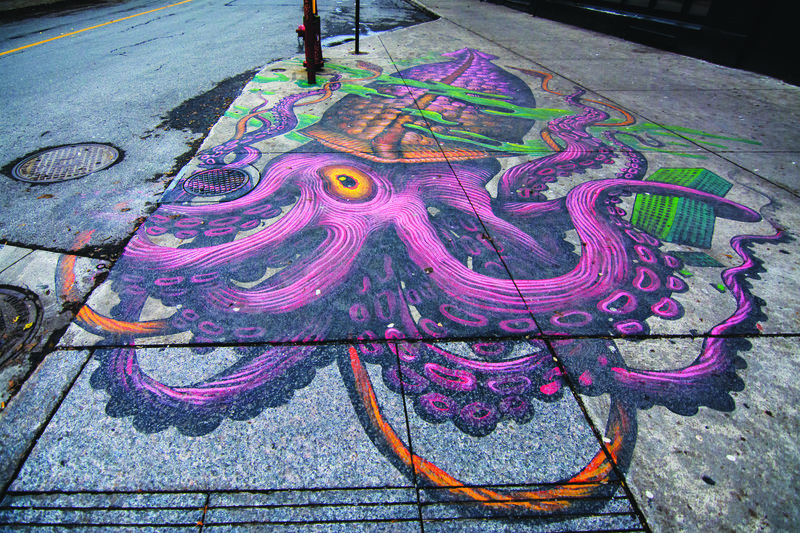“Look up!” is an oft-repeated phrase in today’s society. Whether it’s as an incentive to look up from mobile phones or simply to pay more attention to one’s surroundings, the phrase is echoed countless times in day-to-day life. But in order to enjoy Jason Botkin’s sidewalk art, it’s not up that one must look, but down.
Painted directly onto the ground using paint for house-exteriors, Montreal-based artist Jason Botkin’s 10 pavement pieces are peppered along Boulevard Saint-Laurent. Each one of the pieces is unique, spanning from a psychedelic-looking clown to a giant squid. Botkin was approached by the Business Association of Saint-Laurent in 2016 to create a series of sidewalk art as a part of the Montreal Mural Festival. The works are part of the Business Association’s efforts to revitalise the street and its community.
Initially, Botkin’s vision for his pavement art did not conform to his patron’s requests. Instead of colourful, natural figures, the street artist planned to create a set of works based around issues of homelessness on Saint-Laurent and in Montreal at large. The Business Association refused to back such a project and, eventually, Botkin decided to comply with its requests. He does not, however, view the alteration of his artistic project as a total defeat in expressing his opinions.
“I always use [the pieces] as a backdoor to discuss what I really wanted to talk about,” Botkin said. “I ended up talking a whole lot about the homeless issue without having actually painted it.”
Botkin views his art as a platform through which he can explore issues that he holds close to his heart. One of these matters is environmental degradation, especially issues concerning fresh water. Both Botkin’s giant fish and squid sidewalk pieces illustrate his passion for environmentalism and water conservation.
“I’m really very political in my thinking, in what I do,” Botkin said. “Right now is really a time to be active and vocal about issues. And street art is a beautiful place to have that conversation [….] Street art confronts people where they live, everyday.”
The political nature of Botkin’s street art breaks boundaries, not just in the people it brings together, but also in the questions that it raises.
“I think that anytime that you have a sense of anarchism operating within your field of intention—and street art specifically in its being unsanctioned, is an anarchist activity—you’re going to break boundaries,” Botkin said. “You’re going to offend someone who says that’s not ok. That opens up an awesome conversation like, ‘Who told you it’s not ok? Why are things ok?’ [….] We desperately have to ask those questions and constantly test the fabric of social connection and construction.”
The material space in which Botkin creates his works also questions the spatial barriers of street art, which is traditionally seen on building walls rather than underfoot. This allows Botkin to expand the reach and political impact of his work further.
“Usually when you’re painting on a wall, people won’t come and try to talk to you,” he explained. “When you’re on the street they just walk right up to you [….] I was having really amazing conversations in a way that you can’t do when you’re coming up to someone’s back.”
Through his work, Botkin challenges censorship, social barriers that hinder public dialogue, and even audience expectations of where art should be seen. Botkin draws the viewer’s eye downward to regard the powerful messages expressed by his sidewalk art.







